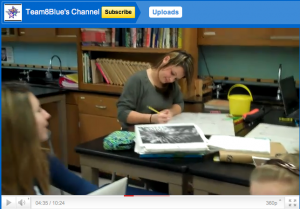I love the idea of digital story telling! Although I don’t teach language arts, I love a good story as much as anyone else and there is nothing better to get kids fired up about their learning than letting them create stories. The stories we made in class today weren’t actually written but drawn on paper and the students talked and shared while they drew. They had to include the seven forms of energy in a super hero style story. First they created their hero and gave them a special weekness to make them more interesting and likeable! Next they drew a disaster for the hero to face. They filled in the rest with the hero’s adventure and finally they helped their hero save the world by restoring energy to the people! Hurray!
We used “Really Big Super Fun Science Paper” otherwise known as newsprint and began with some notes in one corner of the paper to be sure everyone had the background knowledge. I like the large paper because the kids aren’t afraid to mess up and they seem to try to fill up as much of the paper as they can. Think big! We all love when our students are engaged in what they are learning and I was really happy to hear the students chatting while using the vocabulary from our unit. While it is difficult to write and hold a conversation, the students today had no problem talking and drawing at the same time. Everyone was relaxed and enjoyed themselves. I’m hoping that they will remember their own stories and will have a positive attitude about the next lessons that look more deeply into the seven forms of energy.
The Flip Video cameras made it easy to record what the students were doing and everyone (almost) wanted to tell their story to the camera! It added an element of fun to the project and the students enjoyed sharing what they were learning.




